AI and 5G Integration: Transforming Next-Gen IT Services
In the fast-paced realm of technology, two transformative forces, Artificial Intelligence (AI) and 5G connectivity, are converging to reshape the landscape of IT services. As businesses strive for unparalleled efficiency and innovation, the integration of AI and 5G is emerging as a game-changer, unlocking unprecedented possibilities and opportunities.
The Power Duo: AI and 5G
Artificial Intelligence (AI), with its ability to analyze vast amounts of data, learn from patterns, and make real-time decisions, has already made significant strides in revolutionizing industries. On the other hand, 5G, the fifth generation of cellular networks, is not merely an upgrade from its predecessors; it is a technological leap that brings faster speeds, lower latency, and massive device connectivity.
When these two forces unite, the synergy is unparalleled. 5G provides the high-speed, low-latency foundation necessary for AI applications to thrive. This integration is not just about speed; it’s about creating an ecosystem where AI algorithms can function seamlessly, leveraging the full potential of real-time data processing.
Transforming IT Services
1. Enhanced Connectivity and Communication
5G’s low latency ensures that devices communicate with each other almost instantaneously. This is a game-changer for applications like autonomous vehicles, smart cities, and IoT devices, where split-second decisions can be a matter of life or death. AI algorithms, powered by this real-time data, can respond with unmatched precision.
2. Edge Computing Redefined
The integration of AI and 5G is pushing the boundaries of edge computing. With the ability to process data closer to the source, edge computing becomes not just efficient but a necessity. This is particularly crucial for applications that demand quick response times, such as augmented reality and virtual reality experiences.
3. Unleashing Smart Manufacturing
In the manufacturing sector, the combination of AI and 5G is ushering in an era of smart factories. Machines equipped with AI can optimize production processes in real-time, adjusting to changing variables on the shop floor. This not only enhances efficiency but also reduces downtime and maintenance costs.
4. Telemedicine Revolution
The ongoing global health crisis has underscored the importance of telemedicine. With 5G’s bandwidth capabilities and low latency, coupled with AI-powered diagnostics and personalized treatment plans, healthcare is transitioning into a more accessible and responsive domain.
5. Securing the Future
As the integration of AI and 5G progresses, cybersecurity becomes paramount. The interconnected nature of devices and the influx of real-time data create new challenges. However, AI itself can play a crucial role in identifying and mitigating potential threats, making the system robust and secure.
Challenges and Opportunities
While the integration of AI and 5G promises a plethora of benefits, it also poses challenges. The infrastructure required for widespread 5G deployment is substantial, and addressing concerns around privacy and security is imperative. However, as industries navigate these challenges, the opportunities for innovation, efficiency, and economic growth are boundless.
Conclusion
The marriage of AI and 5G is not just an evolution; it’s a revolution. It’s reshaping the future of IT services, creating a world where data is not just abundant but instantly actionable. As businesses adapt to this transformative wave, those at the forefront of AI and 5G integration are poised to lead the charge into the next generation of technological excellence.
For more information, visit Superior Codelabs.
Shaikh Fakruddin is the Founder and CEO of Superior Codelabs.




Comments
Post a Comment